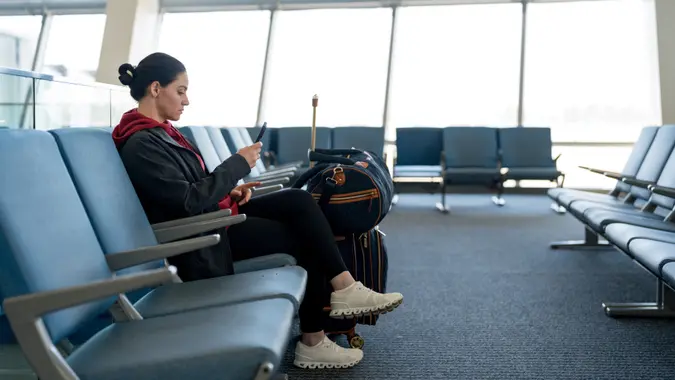7 Everyday Items the Middle Class Should Cut From Their Budget Now To Afford Their Summer Vacation

Commitment to Our Readers
GOBankingRates' editorial team is committed to bringing you unbiased reviews and information. We use data-driven methodologies to evaluate financial products and services - our reviews and ratings are not influenced by advertisers. You can read more about our editorial guidelines and our products and services review methodology.

20 Years
Helping You Live Richer

Reviewed
by Experts

Trusted by
Millions of Readers
It’s always good to review your budget, but trimming your expenses is even more useful if you’re planning a big vacation. Checking monthly credit card statements can help you discover opportunities to reduce expenses and grow your savings account in the process.
The great thing about saving for a vacation is that you don’t have to do it forever. Some cost cuts only have to be in place for a few months, but some people get comfortable with the reduced costs and keep it up. Starting with these seven everyday items can free up space in your budget for an upcoming vacation.
Also find out when is the cheapest time to travel.
Daily Coffee Run
The price of a cup of coffee can cost $5 or higher and if you normally buy a snack with your coffee, those expenses can add up. A $5 cup of coffee each day comes to $150 per month. While many people have used the analogy of how a daily cup of coffee hurts your finances, there is a deeper meaning to it. If you cut this $150-per-month expense from your budget, you’ll become more cost conscious and look for other ways to save money.
Dining Out and Take Out
You can save a lot of money by making food at home instead of dining and ordering take out. Not only will you save money, but cooking is a very valuable skill that can bring families together. Eating homemade food at the dinner table is a more intimate feeling than driving over to a fast food restaurant and ordering food. You can still go dining from time to time, but cutting back will free your budget for the upcoming vacation.
Unused Subscriptions
Subscribing to streaming services, online software and gyms takes a bit of thought when you first do it. However, these costs become passive and regularly eat away at your finances. While it’s good to keep a subscription that continues to serve you well, you might have some subscriptions that are no longer worth it. If you aren’t going to the gym or using a streaming service anymore, you should remove it from your monthly budget.
Impulse Amazon and Online Shopping
Online shopping has made it more convenient to buy various products. While it saves a lot of time and money to buy online instead of locally, there is a problem. It’s too easy to impulsively buy things online and sites like Amazon are great at providing product recommendations that catch your eye. Limiting how often you use Amazon in a given week can curtail impulsive online shopping. You can also write a list of the things you want before going to Amazon. If there’s a product that looks interesting that isn’t on your list, put it on your wishlist and check in after 30 days. If you still want the product after 30 days, it may make sense to buy it. However, you can make those purchases after the summer vacation.
Brand-Name Groceries and Household Items
Brand-name companies have been around longer, but you can find household items and groceries from smaller companies at lower prices. The lower price doesn’t mean that the under-the-radar company offers bad products. It’s simply a reflection of smaller companies having to charge lower prices to compete with brand names. Using alternatives can help you save money so you can afford the summer vacation.
Expensive Gifts
Birthdays and other special occasions may warrant buying a gift, but you don’t have to go over the top. Instead of spending $100 on a gift, consider spending $25 to $50. A sentimental, affordable gift can carry more value than an expensive gift that lacks meaning. You will also have more money in your savings account.
New Items
Buying new items costs more than buying old items, even though both items can be of similar value. For instance, a book from a thrift store is typically in decent condition and costs much less than a new copy of the same book. You can also extend this to fashion and do your shopping in thrift stores instead of buying the latest fashion items. You’ll get the most savings from this strategy if you buy a reliable used car instead of a new car from the dealership.
More From GOBankingRates
- Nearly 1 in 3 Americans Hit by a Costly Holiday Scam, Norton Survey Shows -- How To Avoid This
- Here's What the Average Social Security Payment Will Be in Winter 2025
- How Middle-Class Earners Are Quietly Becoming Millionaires -- and How You Can, Too
- The Easiest Way to Score $250 for Things You Already Do
 Written by
Written by  Edited by
Edited by 

























